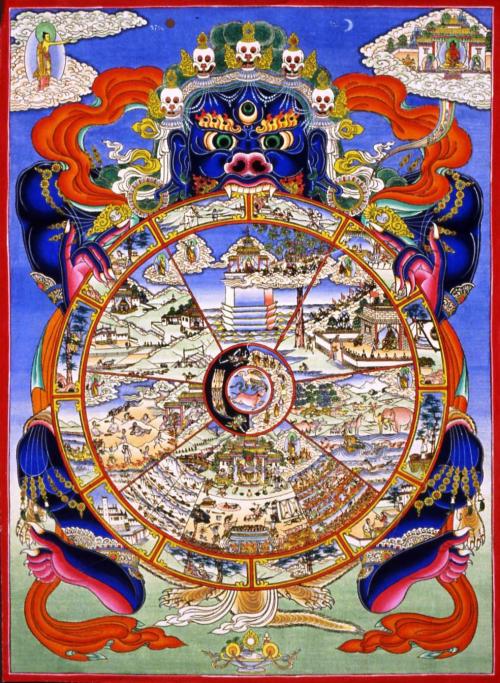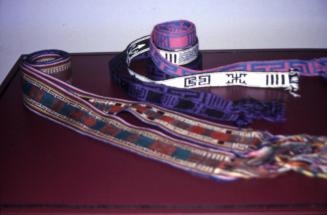Auspicious Signs: Tibetan Arts in New England - Kalsang Jorden
Subject
Kalsang Jorden
(Tibetan, died 2006)
PhotographerPhotographed by
Phillip Fortune
Date1996
MediumPhotography; color slides on plastic in cardboard mount
ClassificationsGraphics
Credit LineConnecticut Cultural Heritage Arts Program collections
CopyrightCopyright Held by Phillip Fortune
Object number2015.196.203.1-.3
Description2015.196.203.1: Slide showing Tibetan Thangka painting, of Chakdor, Protector from evil. Fierce and powerful, the protector deities guard the faith of Buddhism. Acrylic and poster colors on canvas. Loaned to the "Auspicious Signs: Tibetan Arts in New England" exhibit by the artist.
2015.196.203.2: Slide showing The Wheel of Life, which explains the Buddhist concept of life, death, and rebirth according to the principle of karma. Acrylic and poster colors on canvas. Loaned to the exhibit by the artist.
2015.196.203.3: Slide showing Tibetan Thangka painting of Dolma (White Tara), a goddess representing long life. Tara is revered by Tibetans as a beloved protectress and a deity who fulfills wishes. Acrylic and poster colors on canvas. Loaned to the exhibit by the artist.
NotesBiographical Note: Kaljor, as he was known, practiced a variety of art forms. His primary training was in India where his parents settled after leaving Tibet. After secondary school in Mussoorie he attended the Tibetan Homes Foundation Art School for teaching many Tibetan arts including weaving, carving, and painting. Kaljor learned techniques of drawing and painting thangkas from his teacher, Jamyang Losal from Amdo, Tibet, studying with him for nearly four years.2015.196.203.2: Slide showing The Wheel of Life, which explains the Buddhist concept of life, death, and rebirth according to the principle of karma. Acrylic and poster colors on canvas. Loaned to the exhibit by the artist.
2015.196.203.3: Slide showing Tibetan Thangka painting of Dolma (White Tara), a goddess representing long life. Tara is revered by Tibetans as a beloved protectress and a deity who fulfills wishes. Acrylic and poster colors on canvas. Loaned to the exhibit by the artist.
Kaljor was a skilled colorist. He was very modest about his ability to draw the complex designs of a thangka painting, explaining that every detail of a picture is set out in Buddhist texts - all the proportions, poses, characteristics, and colors of the deities. The artist is not at liberty to change these depictions, and must spend years practicing in order to gain facility in drawing correctly. Only monks understand fully the significance and details of Buddhist doctrine, after years of studying the texts. So Kaljor's work focused on coloring, shading, and finishing a drawing outlined by his teacher. He was also experienced in preparing the cotton canvas before drawing.
For several years Kaljor lived in Nepal, apprenticing and then working as a carpet designer in a workshop where weavers made handmade rugs. He also drew and painted secular pictures featuring colorful floral designs or fantastic animals, both on paper and on walls. The traditional technique for wall painting begins with a design on paper which is held up to the wall, pierced along its lines, then dusted with dust chalk so that the outline transfers through the holes onto the wall. The design is then painted, with shading and, in special cases, gold applied.
"I wish to! I wish to go to Tibet...the Chinese, everything is under their control... We want to get our country back. We want to go there when it's independent, not under Chinese...Our Tibetan people are scattered through the four corners...My mother's sisters are all in Tibet...the worst thing is, there is no freedom. That is the worst thing. In my (astrological) calculation I was told to draw (the goddess) Tara. After the completion I go to the high lamas - lama is our Tibetan priest. Once the picture was blessed, it's like it is given a soul. So we just keep it...very sacred." Kaljor passed away in 2006.
Subject Note for 2015.196.203.2: Thangka painting of The Wheel of Life. The picture explains the Buddhist concept of life, death, and rebirth according to the principle of karma. The form in which a being is reborn into the Universe depends upon his yearnings, prayers, and the amount of merit and demerit he has stored in his past life.
The figure holding the wheel is Shenje, ruler of the dead, signifying impermanence and the death that all beings must eventually face. Outside the wheel is Buddha, who has transcended the cycle of life.
The wheel is divided into three parts: axle, spokes, and rim. Half of the axle (central circle) is black, representing hell, while the other half depicts heaven. A white line leads from this heavenly realm up to Buddha. At the hub reside the three poisons: ignorance (pig), hatred (snake), and greed (rooster). The spokes of the wheel are divided into six sections: Gods, Demi-gods, Humans above; Animals, Ghosts, and Hell below. The rim, symbolizing the cycle of life, depicts twelve scenes from birth through death.
Acrylic and poster colors on canvas. Loaned to the exhibit by the artist.
Subject Note: "Auspicious Signs: Tibetan Arts in New England" was an exhibit project developed by the Connecticut Cultural Heritage Arts Program (CCHAP) at the Institute for Community Research in Hartford in 1996. The exhibit opening and a festival of Tibetan arts and music served as the major public events of an eighteen-month research and programming project conducted by CCHAP in partnership with the Tibetans. The project celebrated the Tibetan community's preservation and practice of their traditions in America.
Since the Tibetan Resettlement Project brought twenty-one Tibetans to live in Connecticut, the state has become home to one of the fastest growing Tibetan communities in the United States. Several Connecticut Tibetans are traditional artists of great skill who are deeply committed to expressing and passing on Tibetan culture. Members of the Tibetan community are also dedicated to educating others about the difficult history and circumstances of the Chinese occupation of Tibet.
The collaborative project team consisted of three Tibetan project assistants, exhibit designer Sarah Buie, the Tibetan Cultural Center of Connecticut, artist Sonam Lama who was at the time Vice President of the Massachusetts Tibetan Association, and curator/folklorist Lynne Williamson, then director of CCHAP. The interdisciplinary nature of the team served to broaden the project's outreach to regional Tibetan communities as well as to incorporate a rich variety of expertise and perspectives.
The project team produced an exhibit displaying Tibetan religious art as well as everyday traditional arts, a day-long festival featuring artists, performers, demonstrations, and discussions, and an illustrated catalogue. Artists Jampa Tsondue, Ngawang Choedar, and Tsering Yangzom were featured in a video documenting their artistic process.
Funders included the Lila Wallace Readers Digest Community Folklife Program administered by the Fund for Folk Culture and underwritten by the Lila Wallace-Reader's Digest Fund; the National Endowment for the Arts Folk and Traditional Arts Program, the Connecticut Commission on the Arts, the Connecticut Humanities Council and the Institute for Community Research.
To mark the exhibit opening, the Tibetan community held a festival attended by over three hundred people, including Tibetans from all over the region. Four music and dance groups performed outside, while in the exhibit gallery three Tibetan artists demonstrated weaving, woodcarving, and thangka painting. The event also featured a bazaar, a common Tibetan cultural activity. Many Tibetans are keen traders, maintaining links to Dharamsala, India, and Nepal through import of goods to the U.S. and sale through small shops here. Six Tibetan vendors from all over the region set up tables during the festival with a great variety of Tibetan books and crafts. Lakedhen and five other community members had risen at dawn to prepare food, which they sold during the day. Several speakers described the background of the project, the story of the Connecticut community, the current political situation in Tibet, and the history and character of Tibetan culture. Cholsum dance group from New York City and musicians Lakedhen and Thupten performed and accompanied the dancers. Singer DaDon and her group played for over an hour.
Additional audio, video, and/or photographic materials exist in the archive relating to this artist.
Cataloging Note: This project was made possible in part by the Institute of Museum and Library Services MA-245929-OMS-20.
Status
Not on viewJampa Tsondue
2018 March 10
2000-2001 December-March
















